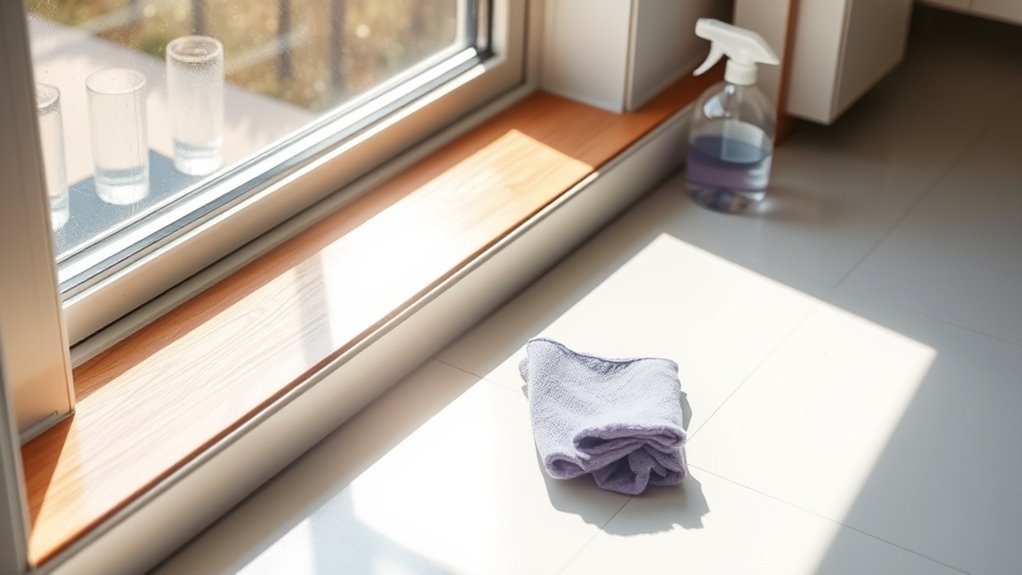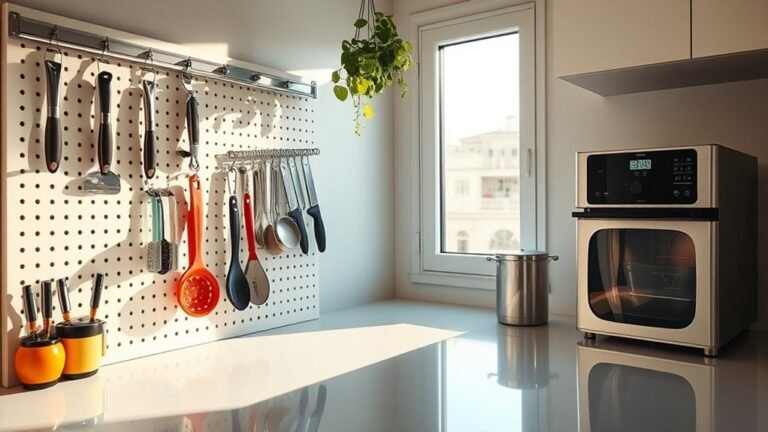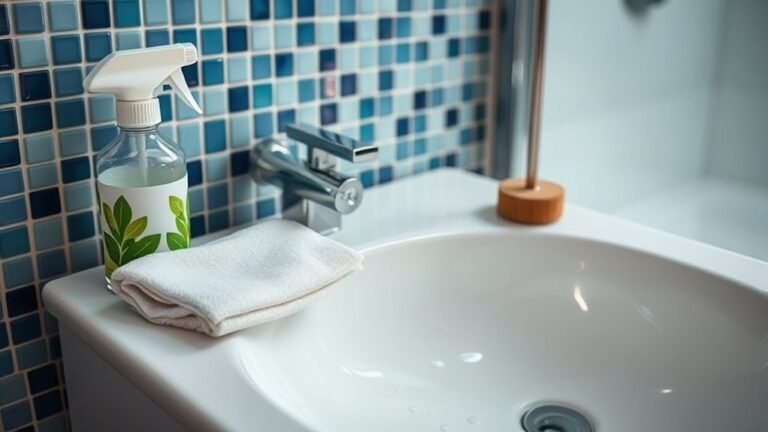How to Clean Windowsills Floors
To clean your windowsills and floors, start by gathering cleaning supplies like cloths, mild cleaner, broom, and mop. Dust and remove debris from windowsills using a soft cloth or brush, treating any mold or stains with a gentle solution. Wipe down the windowsills thoroughly, then sweep or vacuum floors to clear dirt. Mop floors with a suitable cleaner, focusing on corners near windows. Keeping a regular cleaning schedule makes maintenance easy. For tips on deeper cleaning and upkeep, you can explore further advice.
Gather Necessary Cleaning Supplies
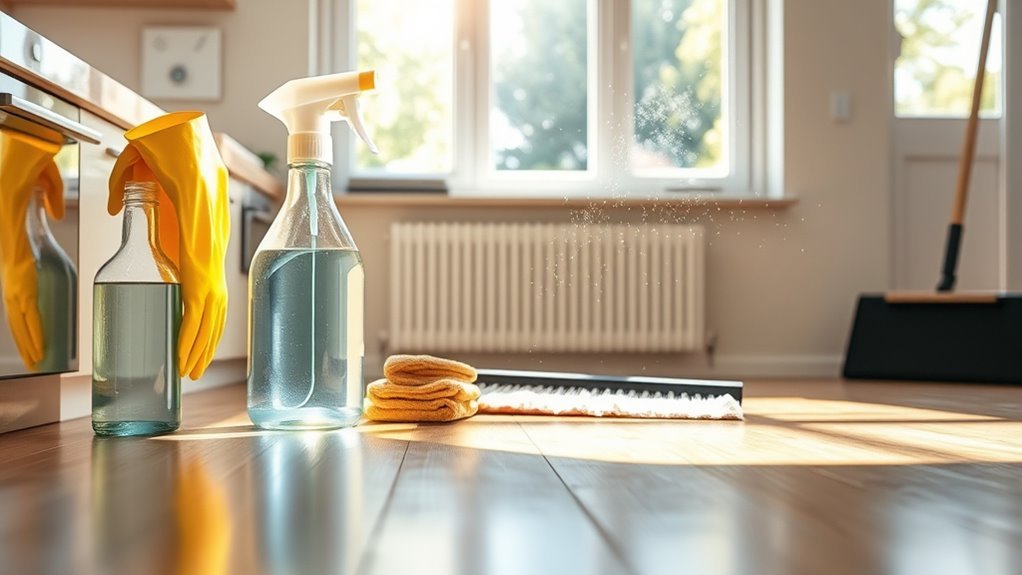
Before you begin cleaning your windowsills, you’ll want to gather all the necessary supplies to make the job easier and more efficient. Depending on your window materials—whether wood, vinyl, or metal—you’ll need specific cleaning techniques to avoid damage. Start with a gentle all-purpose cleaner or a mild soap solution, especially for delicate wood. Have soft cloths or microfiber towels ready to prevent scratches and streaks. A small brush or an old toothbrush will help you reach tight corners without harming surfaces. Gloves protect your hands while giving you freedom to work longer. By preparing these supplies in advance, you’ll approach your cleaning task confidently, ensuring your windowsills remain spotless and intact without unnecessary hassle or risk. This sets you up for success with minimal effort.
Remove Dust and Debris From Windowsills
Start by clearing away the bulk of dust and debris from your windowsills using a soft brush or vacuum with a brush attachment. This simple step sets the stage for effective cleaning techniques that keep your space fresh and unrestricted. Don’t just push dust around; lift it away to prevent it from settling back or spreading. Using a handheld vacuum can make this quicker and more thorough. After removing loose particles, wipe down the surface with a damp cloth to catch finer dust. Regularly practicing these steps not only cleans but helps with dust prevention, reducing allergens and grime buildup. Taking control of this routine lets you maintain a clear, open environment that supports your freedom from constant dirt and mess.
Treat Mold and Stains on Windowsills
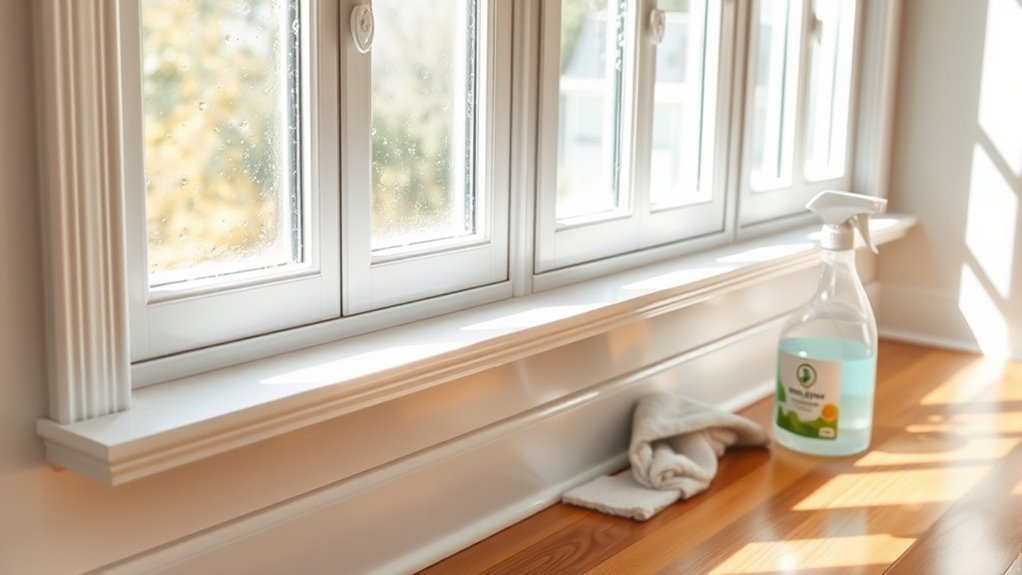
Mold and stains can quickly take over your windowsills if left untreated, so it’s important to address them promptly. Tackling these issues not only enhances your home’s look but also supports mold prevention, keeping your space fresh and healthy. Here’s how you can handle it efficiently:
- Identify and isolate affected areas to prevent mold spores from spreading.
- Use a gentle scrub brush with a mix of water and vinegar or a mild detergent to tackle stubborn stains.
- Dry the windowsill thoroughly after cleaning to discourage mold growth and maintain stain removal success.
Wipe Down Windowsills With Cleaning Solution
Grab a soft cloth and your preferred cleaning solution to wipe down your windowsills thoroughly. This step is key to windowsill maintenance, ensuring dirt, dust, and residue don’t build up over time. Choose a cleaning solution that suits your surface—whether it’s wood, vinyl, or painted. Apply it sparingly to avoid excess moisture, which can cause damage or mold. Wipe in smooth, even strokes, paying attention to corners where grime tends to hide. This simple routine frees your space from grime and keeps your windowsills looking fresh and inviting. By regularly using appropriate cleaning solutions, you take control of your environment, maintaining a clean, healthy home without hassle or restriction.
Sweep and Vacuum Floors Thoroughly
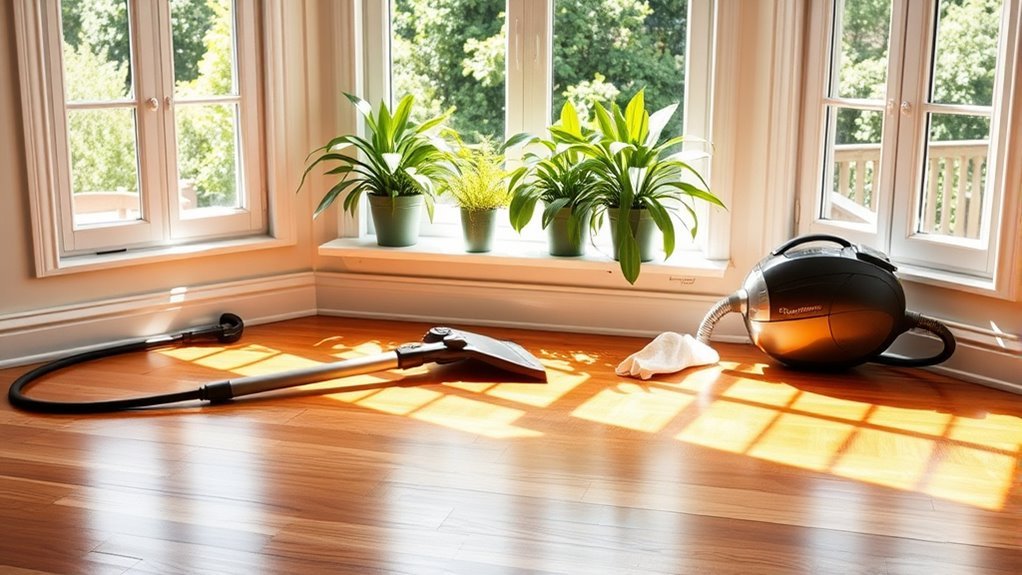
Before you start cleaning, make sure you choose the right broom or vacuum for your floor type. You’ll want to remove all dust and debris, paying special attention to corners where dirt tends to build up. This step helps keep your windowsills and surrounding areas truly clean.
Choose Proper Cleaning Tools
Choosing the right cleaning tools is essential for making the task easier and more effective. When tackling your windowsills, you want tools that give you freedom from hassle and harsh chemicals. Here’s what you should consider:
- Microfiber cloths – perfect for trapping dust without scratching surfaces, and they work great with eco friendly alternatives.
- Spray bottles – fill them with your preferred window cleaning products or homemade vinegar solutions to avoid buying harsh chemicals.
- Small handheld vacuum – great for quickly removing debris without spreading dust everywhere.
Remove Dust and Debris
A thorough sweep and vacuum of the floors around your windowsills is an essential first step in removing dust and debris that can settle there. By using effective dust removal techniques, you’ll prevent buildup that often goes unnoticed but impacts the cleanliness of your space. Start with a broom to loosen stubborn dirt, then switch to a vacuum with a crevice tool to reach tight spots, ensuring no particles escape your notice. This combination maximizes debris disposal methods, helping you maintain a fresh, dust-free environment. Taking control of this step not only keeps your floors pristine but also gives you the freedom to enjoy a cleaner, healthier home without hassle or delay. It’s a simple routine that makes a big difference.
Focus on Corners
After clearing dust and debris from your windowsills, pay special attention to the corners where dirt often hides. Mastering corner cleaning techniques guarantees no spot is overlooked, giving your floors a truly fresh look. Here’s how to nail effective corner dusting:
- Use a narrow brush or vacuum attachment to reach tight corners easily, loosening trapped dust without scattering it.
- Sweep gently toward the center from each corner to gather debris efficiently, avoiding missed spots.
- Finish by vacuuming thoroughly, including edges and behind furniture, to remove hidden dirt and allergens.
Mop Floors Using Appropriate Cleaner
You’ll want to pick a mop that suits your floor type to avoid damage. Choosing the right cleaner is just as important to keep your floors spotless without leaving residue. Let’s look at how to select both for the best results.
Choosing the Right Mop
Choosing the right mop can make all the difference when cleaning your windowsills and surrounding floors. Picking the perfect mop means understanding mop types and mop materials that suit your space and lifestyle. Here’s what to take into account:
- Microfiber mops: Lightweight and highly absorbent, they’re great for quick, efficient cleaning without leaving streaks.
- Cotton mops: Durable and ideal for heavy-duty tasks, but they take longer to dry and can be bulky.
- Sponge mops: Perfect for smooth floors and easy wringing, offering control without too much effort.
Choosing a mop that fits your freedom to move and clean effortlessly guarantees your windowsills and floors stay spotless without hassle. Keep it simple, effective, and tailored to your way of living.
Selecting Suitable Floor Cleaner
Picking the right mop sets you up for easier cleaning, but the cleaner you use matters just as much. When selecting a floor cleaner, you want something effective yet gentle, especially if you’re aiming for eco friendly options that respect both your home and the planet. Don’t settle for harsh chemicals that limit your freedom to breathe easy indoors. Take some time to explore brand comparisons online—many brands now offer biodegradable formulas that still pack a punch on dirt and grime. Look for labels highlighting natural ingredients and non-toxic claims. Choosing the right cleaner allows you to maintain spotless floors without sacrificing your values or health. With the right product in hand, you’ll enjoy a cleaner space and the freedom to live sustainably.
Maintain Cleanliness With Regular Cleaning Schedule
Although it might seem tedious, sticking to a regular cleaning schedule is key to keeping your windowsills spotless. By setting your cleaning frequency, you prevent dirt buildup and save time in the long run. Here’s how to maintain that freedom from grime without feeling chained to chores:
- Choose a cleaning frequency that fits your lifestyle—weekly or biweekly works well for most.
- Use schedule reminders on your phone or calendar to keep you on track without stress.
- Combine windowsill cleaning with other routine tasks to stay efficient and free up more time.
Frequently Asked Questions
Can I Use Vinegar to Clean Wooden Windowsills?
Imagine your wooden windowsills basking in a gentle morning rain—that’s the kind of freshness vinegar can bring. You can definitely use vinegar as a natural cleaner, but you’ll want to dilute it with water to keep your wood’s spirit intact. It’s a free-spirited way to care for wood, avoiding harsh chemicals while preserving its charm. Just remember to test a small spot first, so your windowsills stay as lively as your desire for freedom.
How Often Should I Deep Clean Windowsills and Floors?
You should set a cleaning frequency that fits your lifestyle and space. For windowsills and floors, deep clean them every one to two weeks as part of your maintenance schedule to keep dirt and allergens at bay. If you want more freedom from constant upkeep, aim for biweekly deep cleans and quick touch-ups in between. This way, you maintain a fresh environment without feeling tied down by chores.
What Are the Best Ways to Prevent Mold on Windowsills?
Did you know that mold growth increases by 20% in homes with poor humidity control? For effective mold prevention on your windowsills, you’ve got to keep humidity levels below 50%. Use a dehumidifier or open windows regularly to boost airflow. Wipe down windowsills often to remove moisture, and fix any leaks promptly. By controlling humidity and staying proactive, you’ll enjoy a fresher, mold-free space without feeling trapped by constant cleaning.
Are Steam Mops Safe for All Floor Types?
Steam mop effectiveness depends a lot on your floor type compatibility. While steam mops work wonders on sealed hardwood, tile, and laminate floors, they’re not safe for unsealed wood, vinyl, or certain delicate surfaces. If you want to keep your floors looking great without damage, check your floor’s material first. Using a steam mop on incompatible floors can cause warping or peeling, so always follow manufacturer guidelines to enjoy cleaning freedom safely.
How Do I Protect Windowsills From Sun Damage?
Think of your windowsills as silent guardians, craving protection from relentless sun rays. To shield them, you can apply window film that acts like a UV protectant, blocking harmful rays before they cause damage. You’ll keep your space bright and your sills safe, freeing yourself from constant worry. Plus, some films even reduce glare and heat, giving you more control and comfort in your personal sanctuary.
